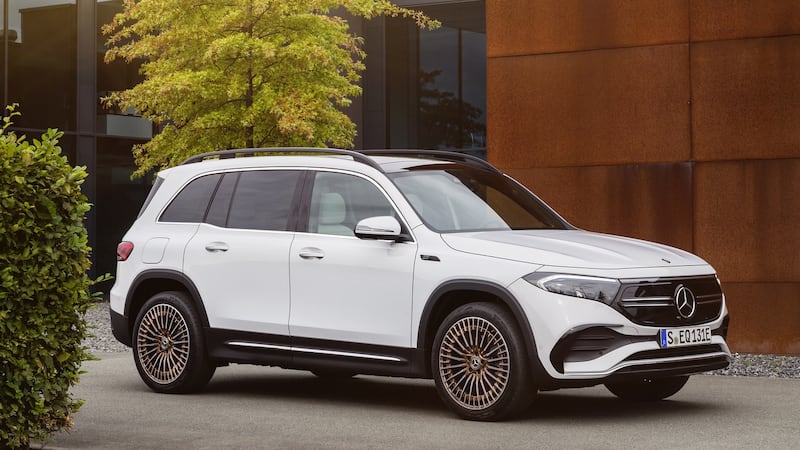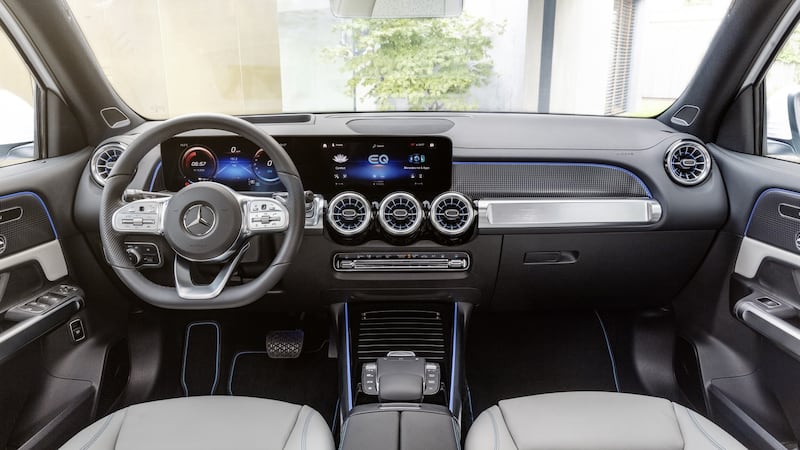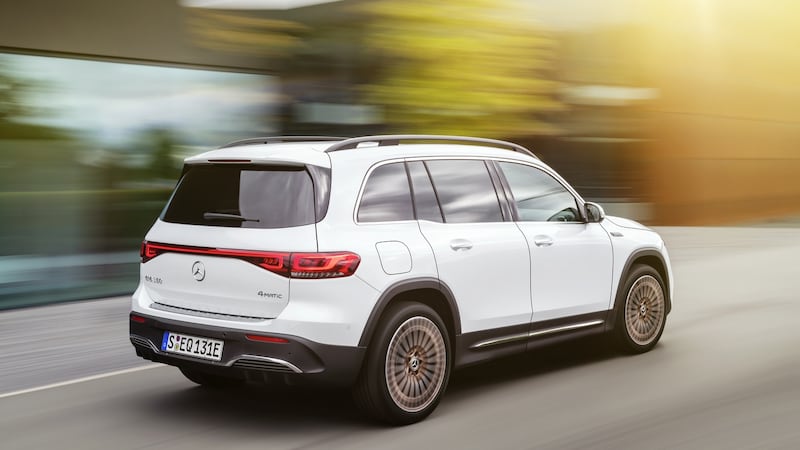Mercedes may have missed the initial charge to electric, but it is certainly making up for lost time. And the introduction of a seven-seat EV would seem like a very smart move given the sparsity of options for larger families seeking plug-in transport options.
Mercedes’s new EQB is just one of six all-electric models in the German car giant’s fleet these days. The latest to join was the flagship EQS saloon, an electric equal to the S-Class and the EQE, the electric equivalent of E-Class.
Both make range anxiety seem redundant, with more than 700km claimed by the EQS and 650km in the EQE. With a target to offer only an all-electric range to Irish customers from 2030, the move is on to have an all-electric version of every model offering in its fleet by 2025.
And if you think 700km is impressive, then consider the brand's EQXX all-electric coupe, which in April completed a run from Sindelfingen in Germany to Cassis in France, a journey of 1,008km, on a single charge. In fact, when it reached its destination, Mercedes says the battery pack still had 15 per cent of its charge left. Though the EQXX is currently a concept car, a production version is planned to arrive in 2024.
Clearly, the company that invented the modern automobile isn’t going to be left behind in the new electric age.
Part of this product offensive has led us behind the wheel of the EQB, basically an all-electric version of the smart-looking GLB crossover SUV. Boasting the styling traits – akin to a shrunken G-Wagon – that wins favour on the GLB, the biggest boon of this all-electric version is that it boasts a battery big enough to deliver a range of 419km yet still retains its seven-seat format.
Admittedly, that third row of seats is only for the two smallest members of the clan, but access is helped by a sliding second row.
It’s also a level of flexibility – combining both range and seating – that few brands are currently able to deliver right now, at least without opting for a converted van or else carrying a price tag close to €90,000 or more.


Inside, the EQB’s boxy format delivers a set-up you’d normally get from a larger SUV, the seats more upright, the dash and steering wheel more vertical and the front windscreen less raked than most crossover rivals. However, it’s only when you rock up beside a regular crossover that you realise you’re actually noticeably lower to the ground. It may boast G Wagon silhouette, but it’s closer to a family hatchback when you mix it among the Irish traffic.
The good news here is that you get nearly 500 litres of bootspace in five-seat format and a whopping 1,701 litres with the second row folded down as well.
It’s not just the seven seats that impress; overall, the cabin is a proper premium affair. There are a few plastic elements that on the tactile test feel a little below par, but overall the finish fits the Mercedes brand. Of particular note is a quirky interior lighting set-up, with waves of green light dancing across the dash when the car is charging. In fact, the EQB’s cabin really comes to life at night. It’s surprisingly fun for a brand that many normally regard as the more sober and serious end of German premium motoring.
On the road, acceleration is relatively sedate for an EV. While there is plenty of initial poke, the 228hp electric motor pushes this hefty car along to a 0-100km/h time of eight seconds. That’s pretty tame for an electric car, where neck-snapping torque seems like standard fare.
Indeed, that time is slower than the new Kia Niro EV, and certainly not within the ballpark of the Tesla Model Y and its five-second sprint to 100km/h. Even at Merc, the GLB 200 diesel, for example, hits 100km/h from a standing start in nine seconds. Yet the pace suits the car, and no doubt contributes to the range between charges.
Not that many will complain. There seems to be an increasing chorus from EV passengers who are sick of the seatbelt tugs and rollercoaster ride of fast acceleration followed by heavy braking that feature on trips with newly enthused EV drivers.


There is a problem, however, with equating the EQB with similar-sized siblings from the regular fleet: price. The electric versions, albeit more powerful and well-equipped than the entry-grade of a petrol or diesel equivalent, are still expensive.
This EQB 300 4Matic starts at €65,660. That compares to a starting price of €49,460 for a GLB 200 diesel automatic, or €51,080 for a GLB 180 petrol.
That's before you take a look at the opposition. True, the likes of the Skoda Enyaq and its VW Group siblings may not have the same cache as the three-pointed star – not the third row of seats – but you could get longer-range versions for less than this Merc. They can also charge faster, with the EQB taking a max charge of 100kW from a DC charging point. Still, Mercedes claims you can get 140km after 15 minutes plugged into the fast chargers.
Admittedly a front-wheel drive single-motor version is in the plan, which should mean a lower starting price.
Right now, you get the dual-motor four-wheel drive seven-seat format, but you also end up with a small crossover that weighs in at more than 2,200kg and therefore delivers a range that’s generally lower than its five-seat rivals. Bigger EVs with less prestigious badges manage better range for this sort of cash.
There is an avid market for EVs and seven seats is a sweet spot for many family buyers. The end result could be better, but we still expect buyers to be forming an orderly queue for the EQB at Mercedes dealers. Or perhaps waiting until they see the price tag on the front-wheel drive version.
Mercedes EQB 300: the lowdown
- Power A two-motor four-wheel drive set-up delivering 226hp and powered by a lithium-ion battery pack with 66.5kWh of usable energy content.
- Range 419km
- 0-100km:h 8 seconds
- Price €65,600
- Our verdict A tempting EV package for family buyers, but could deliver a better range and a more competitive price.











